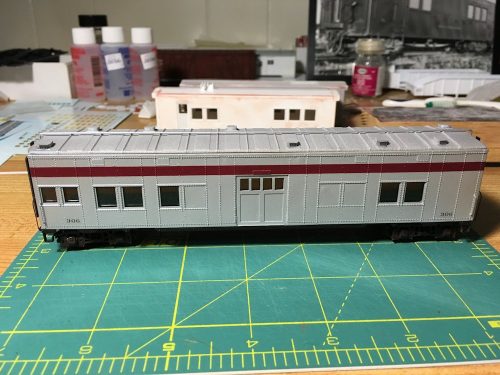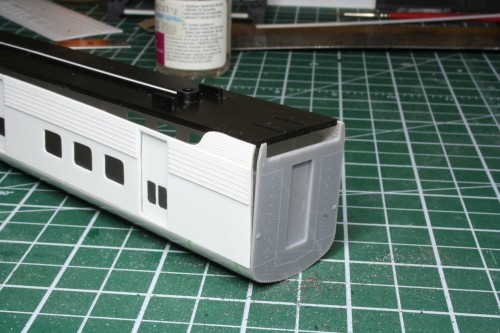Category Archives: Baggage Cars
AC 306 Painted and Assembled
This Sunday I had the advantage of having pretty much the entire day to myself and spent the afternoon masking and painting my modified troop sleeper-cum-baggage car. Earlier in the week, the sides were assembled into the body frame and the body, roof and pipe were separately primered and painted “Aluminum”. Sunday afternoon was spent masking and painting the letterboard stripe (CPR Tuscan/Maroon) and the underbody and sills (flat black).
Once the paint had set and the masking was removed, I installed the window glass (using the original clear parts from the Walthers model for the existing windows and a sheet of clear styrene across the baggage door windows using a bottle of Microscale Kristal Kleer I had on hand (which seems to be more or less basically just regular white glue…?) and then installed the roof. The final bit of assembly involved installing the (previously bent and painted) air? pipe down the roof centreline, gluing it into holes above the end diaphragms, and tacked down at a couple of points to the roof carlines to keep it straight and attached. A small weight was placed on top to hold the pipe down while the glue dried.
With the body painted and assembled, one of the last tasks was to letter the car, which in this case consisted of only adding the car numbers to the four corners of the car using some of the extra digits from the number jumble in the Black Cat ACR passenger set. The railway never did get around to actually applying their name to the maroon stripe on the real car either, so that completes the lettering of this car…
A few final details remain such as stirrup steps below the baggage door and a light (passenger cars usually stayed in pretty good condition) weathering job, but this car is nearly complete!
Troop Sleeper Baggage Conversion Body Modifications and Details
So this project has been on the shelf for a long time. A very long time. I last wrote about this here in September 2013, and even that was to recount work that I had done before I actually started this blog. So far, I’ve posted about scratchbuilding the new doors, and briefly about plating some of the existing windows and vents (the easiest possible part of the job). Some of the work of cutting out the new opening had been started, but never fully cleaned up.
So recently I’ve pulled this out and started to finish that off.
The original troop sleeper configuration has a narrow personnel door in the centre, with single windows on either side. The new baggage door takes up part of this space. So the new opening needs to be marked and cut out, but also parts of the original openings need to be completely filled in. This involves filling in the windows with sheet styrene and removing all of the detail around them, as well as some of the same for the very top of the original door, which was slightly higher than the new sliding door. I used some styrene strip along the inside of the new opening to frame it up and unify the edges where the old window openings were, although this also helped correct some sloppiness in my original cut.
Then body putty was used on all the seams and areas around the door and window fill areas to fill and smooth things out, and everything sanded smooth. A bit of a rounded bevel was also filed into the door posts, although the top edge was left as square as possible.
The new rivet strips along the door posts were added using Micro-Mark 3D rivet decals. The small plate above the door was added using an .060″ wide strip of .005″ styrene with more Micro-Mark decals for the corner rivets. (In older photos this plate seems to have mounted some sort of hook/hanger above the door, probably to assist in hauling up express cargo. It appears though that this hook was removed by 1980s era photos of the car I’m modelling, so I don’t have to try to bend wire into such a small feature. Phew.)
This is really getting this car starting to look like something now, and is pretty much down to a few coats of paint for the next step…
Basic Underframe for AC 300
Sat down again to this project for a while this evening.
I managed to file down the back of the skirting on the “A” end of the car and glue the side back into the end to repair the earlier damage. The floor piece is now able to manuever past the skirting and set into the body. (It’s just dry-fit for now.)
I admit I’m not a total expert to everything that’s going on under passenger cars, and there’s a lot of variation from car to car. Also I don’t have any really nice close-up detail photos of the bottoms of these two cars. Based on the reference photos I do have, I tried to replicate the general outline of what’s under there using the Train Station Products passenger car detail set, which includes a variety of tanks and boxes and other details.
It’s not the most super-detailed underframe, but starting to at least represent the profile of the real thing. I plan on adding at least some piping to represent the air brakes and electrical connections underneath. It’s not going to be 100% accurate, but at least it should have the general impression of the thing.
Shortened Frame and the Flaw in my Plan
The other evening I spent a few minutes filing down my cut underframe for one of these baggage cars. I glued and spliced it together, and wanted to test its fit in the body. Therein began the problem.
Of course the curved bits of the skirting make the bottom of the car a bit narrower, and I wasn’t able to get the underframe in past them. And the laminated sides are actually fairly rigid where they’re glued together and to the ends, so while trying to figure out a way to slip it in there, this happened:
The damage is certainly minor; it just split the brittle CA joint between the side and the end, but it illustrates a bit of a flaw in my assembly sequence.
It’s relatively easily surmountable; I just need to file the backs of the curved skirting down to flatten the back side so that the underframe slides in past them. It’ll make me look at my plan for subsquent cars based on these sides and core kits – either I need to file the backs of the skirts on all these cars, or I really need to make the roof, rather than the floor, the removeable part. If I want to model dropped steps on some of the coaches I have on deck, I may have to do that anyway.
This car’s body and roof have already been glued together as a unit, so it will be repaired and have the backs of the end skirts filed to fit the floor. I’ll revisit this again with the next car.





